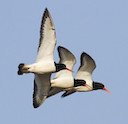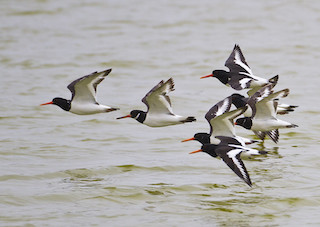 Oystercatchers are often spotted round The Lizard’s shoreline.
Oystercatchers are often spotted round The Lizard’s shoreline.
Photo: © Allan Drewitt/Natural England
Scientific name: Haematopus ostralegus
Other common names: Eurasian Oystercatcher, Common Pied Oystercatcher, Sea Pie
Conservation status: IUCN, Least Concern; Birds of Conservation Concern in Britain, Amber
What to look for:
- Colouring and appearance: Large wader, black head and back, white front, long red bill and reddish-pink legs; white patches on the wings and tail are distinctive in flight
- Size: 40 to 45 cm long and a wingspan of 80 cm
- Where: Most of the British coastline, estuaries, sometimes further inland (especially in Scotland and northern England)
- Call: Noisy, with piping call
- Similar species: Easy to distinguish from other waders in the UK
 Despite its name, and despite being the only wader known to be able to open oysters, the Oystercatcher feeds mainly on cockles and mussels, using its tough flat bill to open bivalve shells. Different Oystercatchers use one of two different methods to open the shells, learned from their parents and showing different bill adaptations according to which method is used: birds with shorter, stubbier bills hammer the shell, while others with more pointed bills lever the two halves of the bivalve shell apart. Oystercatchers also exploit easier pickings, such as worms and soft-bodied molluscs. Its diet makes the species vulnerable to developments on estuaries or commercial exploitation of cockle beds.
Despite its name, and despite being the only wader known to be able to open oysters, the Oystercatcher feeds mainly on cockles and mussels, using its tough flat bill to open bivalve shells. Different Oystercatchers use one of two different methods to open the shells, learned from their parents and showing different bill adaptations according to which method is used: birds with shorter, stubbier bills hammer the shell, while others with more pointed bills lever the two halves of the bivalve shell apart. Oystercatchers also exploit easier pickings, such as worms and soft-bodied molluscs. Its diet makes the species vulnerable to developments on estuaries or commercial exploitation of cockle beds.
There are some 110,000 pairs in Britain in the summer (2009; BTO). Each single clutch of two or three eggs is laid in a scrape on the ground between April and June, and both the male and the female share in the incubation period of just under a month. The young fledge after approximately 35 days.
Did you know…?
…The genus name Haematopus means ‘blood-foot’ and the species name ostralegus means ‘to lift oysters’.
…Oystercatchers live an average of 12 years, but the maximum recorded age is over 40 years.
More information and references:
Gooders, J. and Harris, A., 1986. Field Guide to the Birds of Britain and Ireland. Kingfisher Books, London.
Published: April 2014
Author: Amanda Scott
Photos: © Allan Drewitt/Natural England
